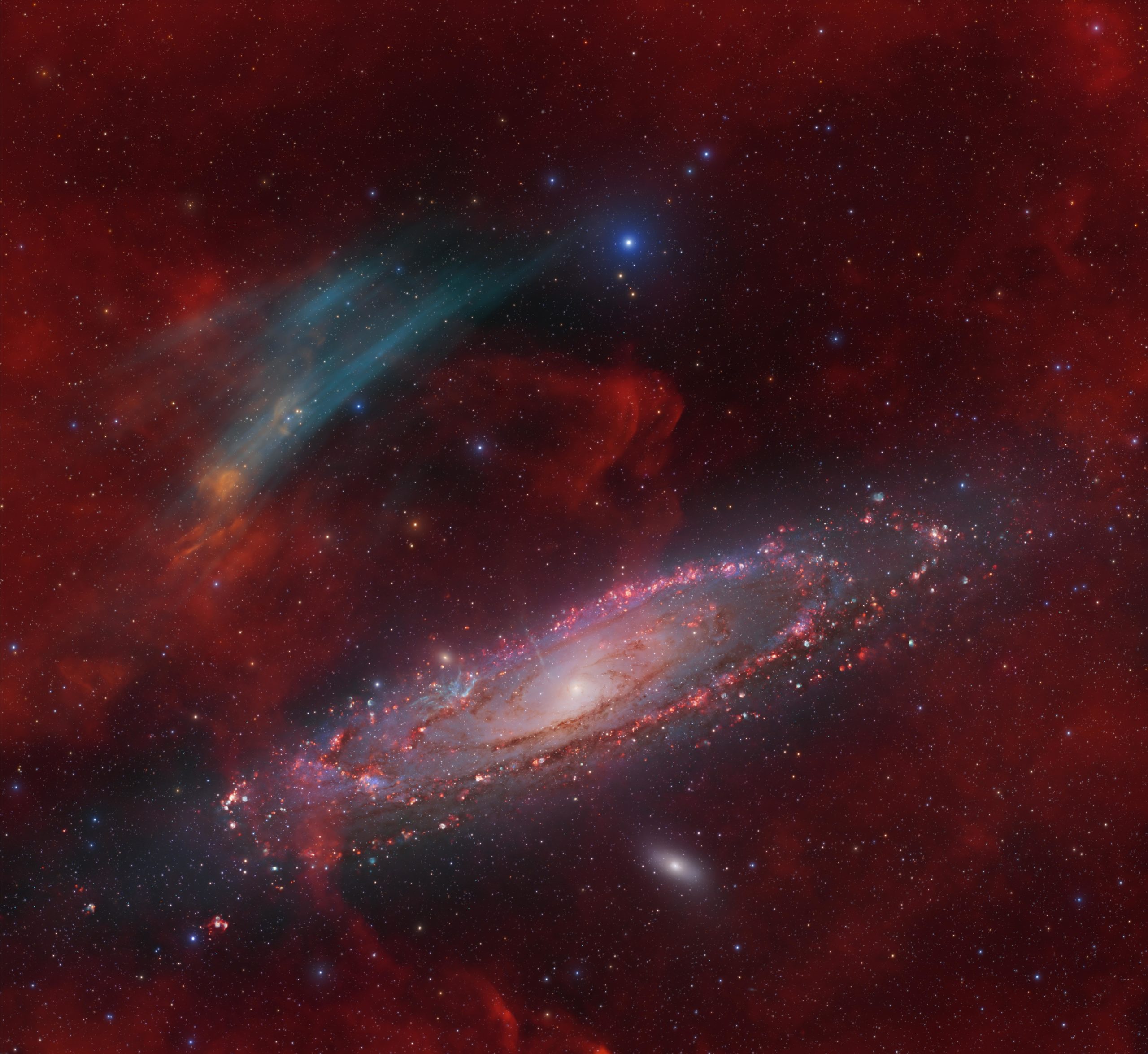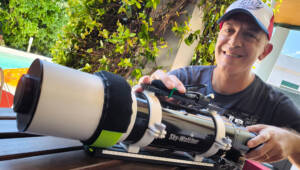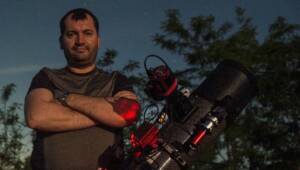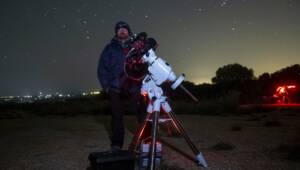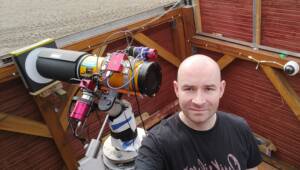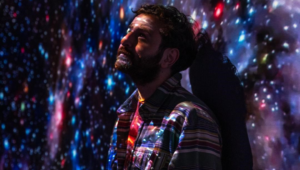Recently, a major discovery by an international team of amateur astronomers and scientists has become a huge online hit, and this new discovery is just located in one of the most studied celestial bodies: the M31 Andromeda galaxy.
The team started this research in August 2022. People generally do not use narrow-band filters when photographing galaxies, but the team did just the opposite. After hours of long-exposure imaging, they were surprised to find a ray of Oiii signal (The blue area in the figure below), the arc has an extent of about 1.5 by 0.45 degrees, only 1.2 degrees from the center of M31, located in the southeast of the main body of the Andromeda galaxy. It may be the largest structure of its kind in the near vicinity of the universe. M31 is undoubtedly one of the most photographed deep sky objects ever recorded, which makes it all the more surprising to find such a large structure so close to the galaxy.
In response to this exciting discovery, we immediately contacted the first author of the paper, Marcel Drechsler, for an exclusive interview. At the same time, he was our ASIWEEK champion and an old friend of our ZWO.
Q1: Can you share with us what is the opportunity for you to discover the M31 [OIII] emission arc? For example, what prompted you to generate long-exposure inspiration?
In early 2022, amateur astronomers and researchers Xavier Strottner and Drechsler brought the French astrophotographer Yann Sainty on board for a very special project. The mission, in addition to photographing a previously unknown nebula from the Strottner-Drechsler catalog (catalog StDr), was to capture no less than a dozen planetary nebulae and candidates in one image, including 4 from the StDr catalog.
Yann Sainty made extreme efforts to provide the team with the best possible data. In the process, Yann covered thousands of kilometers within France in a few months with his mobile setup to find the darkest possible location. This tremendous effort was definitely worth it, as the photo was simply breathtakingly beautiful and of high scientific value. The months of hard work left their mark, of course, and so Yann decided to focus on a relaxing and easy project – the Andromeda Galaxy. A piece of cake and certainly within a few days a completed project thought the astrophotographer – but fate intervened and it came quite differently.
While working on the M31 project, Yann Sainty did something that few astrophotographers before him have done – he used an OIII filter to better bring out the faint HII regions. Since an OIII filter is a relatively new territory in astrophotography, Yann sent the data to Marcel and Xavier for review. Yann’s secret hope, perhaps, was to have a previously unknown planetary nebula or supernova remnant in the data.
The news the Strottner-Drechsler team had for Yann was different than expected but no less interesting. On Yann’s OIII data, in addition to the usual expectable signals within M31, an extremely faint nebulosity appeared at the edge of the image that seemed to continue outside the photo. It could have been one of the known image bugs – a flat error, amplifier glow, a gradient, or a reflection – the list of faults is long. Marcel Drechsler, however, urged Yann Sainty to collect more OIII data, thinking he spotted finer sub-structures in the barely visible nebula.
After many more hours of exposure, the team was sure there was definitely something there. Weeks of research showed that this object could not be assigned to any known structure from- and around M31.
Now began another marathon for Yann Sainty to search every clear night for the perfect dark location for new data and to escape the worsening autumn weather in France. From August to November 2022, Yann Sainty was on the road at every opportunity, once again covering many thousands of kilometers while the research for the discovery was in full swing.
Thus, it took Yann 22 nights over 3 months and thousands of kilometers to collect the 111 hours of exposure time selected for this image and to have maximum data for scientific studies.

Q2: We believe that such an accomplishment cannot be achieved without the support of the team. Can you briefly introduce the team members to us?
Of course, a single person cannot possibly manage such a project. Our team grew in the months since the discovery in August 2022 from 3 people initially to 12 people shortly before the release. We had to be very careful throughout this time who we brought onto the team and who we could trust, because we knew very early on the potential this discovery would have.
Now we would like to introduce our esteemed team:
- The discoverers:
Marcel Drechsler and Xavier Strottner: research, image processing, coordination of the team.
Yann Sainty: astrophotography and data processing
- The scientists:
Professor Robert Fesen, Dartmouth College, Hanover, New Hampshire, USA.
Professor Stefan Kimeswenger, Institute of Astro- and Particle Physics, University of Innsbruck, Austria
Professor Michael Shull, Department of Astrophysical and Planetary Sciences and CASA, University of Colorado, USA
- External astrophotographers for confirmation images:
Bray Falls (USA), Christophe Vergnes (France), Nicolas Martino (France), Sean Walker (USA)
- Object registration
Pascal le Dû, France (planetarynebulae.net)
Quentin Parker, University of Hong Kong

Location: Lorraine, France
Q3: This discovery is a breakthrough! So what do you think this discovery has implications for others in the future?
A good question – definitely this discovery will change the face of the most photographed deep sky object forever. If M31 was always considered a “must-have” among astrophotographers, the OIII arc may turn out to be a baptism of fire for astrophotographers.
Almost more interesting, however, is the scientific footprint this discovery will leave. If it can be confirmed that the OIII arc is really in the immediate vicinity of M31, it would be a small sensation, because it would make the nebula the largest of its kind and at the same time, the team’s photo would be the first one taken of a phenomenon like this.
Q4: What is the current progress of the follow-up spectroscopic study of this emission arc?
The team has been trying to create a spectrum of the nebula for many months, both amateur astronomers and scientists have tested a spectrum on various optics. Due to the immense size of the nebula combined with its extremely low surface brightness, a spectrum is an incredibly difficult undertaking. So far, we have not been able to detect a signal that stands out sufficiently from the background noise to gain insight from it. With the window of opportunity to observe M31 nearly closed, the team has only a few days left and the weather outlook is sobering. But with a little luck, the 2.4m Hiltner Telescope at Kitt Peak National Observatory in Arizona will give us the valuable data we need at the proverbial last minute. If that doesn’t work out, then unfortunately we’ll have to wait until the summer of 2023 for a new attempt.
Q5: Many astrophotographers are stunned by your discovery this time. Could you share some information about the imaging equipment with us?
Yann Sainty:“ I am completely satisfied with my setup, which is both fast and precise. The combination of a high quality and fast astronomical telescope with the camera from ZWO in conjunction with 3nm narrow band filters from Antlia makes it possible to perfectly capture and isolate the signal, such as the OIII for this discovery.”
In particular, the ASI2600MM Pro camera from ZWO is, to me, one of the best cameras currently available for amateur astronomers and astrophotographers.
It is a challenging setup as I use it mostly mobile and takes a lot of time to set up, but when it is set up it is a great pleasure to photograph with. I would like to sincerely thank “Optique Unterlinden” (France) for their professionalism in putting together my setup and recommending the ZWO ASI2600MM Pro.
Setup:
- Telescope: Takahashi FSQ-106EDX4
- Imaging camera: ZWO ASI2600MM Pro
- Mount: Sky-Watcher EQ6 Pro
- Antlia filters (36 mm): 3nm H-alpha , 3nm Oxygen III, Blue , Green, Red and Luminance
- Accessories: Pegasus Astro Powerbox Advance Gen2 – Primaluce Lab SESTO SENSO 2 – ZWO EFW 7 x 36mm
- Software (data acquisition): Cyril Richard Siril – Open PHD Guiding Project PHD2, Nighttime Imaging ‘N’ Astronomy (N.I.N.A. / NINA).

Thanks to Marcel for bringing us attentive answers, so that we can know more interesting tidbits about this discovery. There is no doubt that this discovery is stunning, and it is a milestone step, not only a contribution to scientific research but also an incentive for amateur astronomers. Today, with the rapid development of astrophotography cameras, the threshold of astronomical research is also continuously lowered, and amateur equipment can also make their own contributions to the research of astronomy with a large FOV and narrow band. What is admirable is the spirit of exploration of this team. When the results are uncertain, they firmly believe in their own ideas, overcome difficulties such as cross-national collaboration and weather effects, and image the same target for several months. Undoubtedly, they have proved to the world that, amateurs can do a lot too!
Browse their papers here: https://bit.ly/3iy3WKQ
Full resolution: https://bit.ly/3X4JeRy

